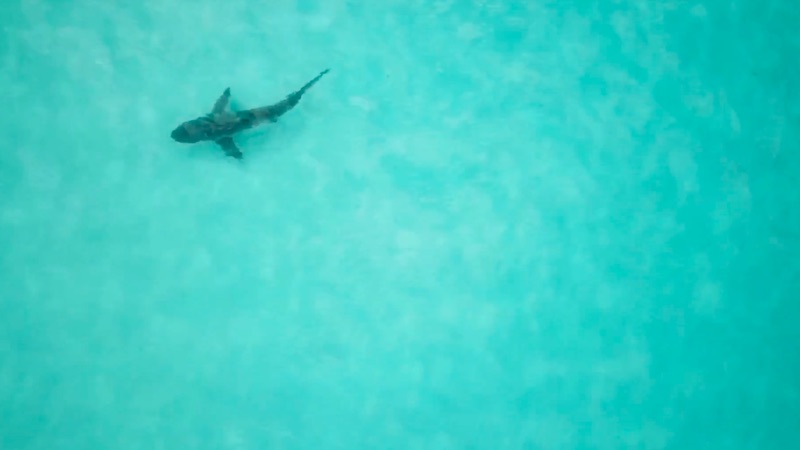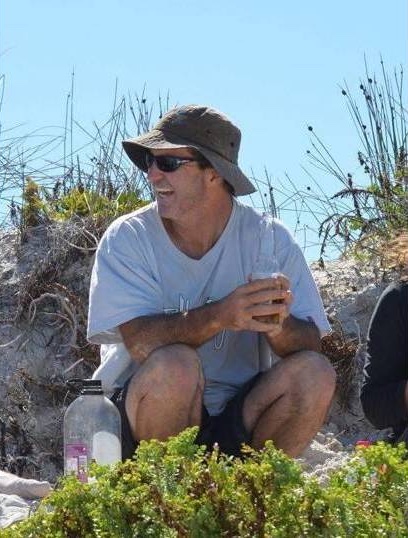
Drone angle of a shark cruising through the crystal waters of Esperance, WA. Screenshot: YouTube/Leo Hermans
“We’re not just about a cull,” says Mitch Capelli. “We’re a group made up of ocean lovers and ocean users and we have a care for sea life. We don’t want things to be killed.
“But there’s got to be a middle ground. It’s so obvious that the balance in nature is out of whack. When people are being killed, you can’t make that (green) argument, you don’t have a leg to stand on.”
Mitch, founder of the Esperance Ocean Safety and Support Group, has been lobbying for action on shark mitigation for years.
Yesterday, he sounded rattled as hell.
It’s not surprising. Esperance might be the most dangerous surf town in Australia right now.
The dreadful attack on local surfer Andrew Sharpe last Friday, at the town’s go to surf spot of Kelpies, and his subsequent disappearance makes two fatalities in the past year.
They followed the death of 17-year-old visiting surfer Laeticia Brouwer, also at Kelpies, in 2017.
All have involved great white sharks.
Despite this tragic series of events, shark mitigation and attack prevention in the area has been all but ignored by the State Government.
Shark mitigation in WA is run by the State’s Department of Primary Industry and Regional Development. On the department’s website, it advocates protecting yourself by using your “Sea Sense”. (Check the WA DPIPD’s advice for water users, including the “sea sense” line, here.)
That, or taking advantage of a $200 rebate on a personal shark protection device.
Given the toll in Esperance, and in Australian waters generally in recent years, this seems laughably inadequate.
Whatever a “sea sense” is, it didn’t help Andrew Sharpe — and he was the type of person you’d think would have it in spades. Andrew was “a local legend,” says Mitch. “He had a good eye for the water, he was always shredding, always had a smile on his face, and was always good fun to hang out with after a surf and have beers in the carpark. It doesn’t feel real that we won’t be seeing him again.”
The crew in the water with him “are really rattled. They don’t ever want anyone to see something like that again”.

“He had a good eye for the water, he was always shredding, always had a smile on his face, and was always happy to hang out after a surf and have beers in the carpark. It doesn’t feel right that we won’t be seeing him again.” Mitch Capelli on Andrew Sharpe, who sadly lost his life while surfing in Esperance on Friday. Source: WA Police
What is mitigation in Esperance? Currently there are four VR4G “smart” receiver buoys in local waters, including one off Kelpies. Like the arrays off the NSW north coast, they’re designed to pick up the presence of radio-tagged sharks.
Shark towers were put in place following the shark attack death of diver Gary Johnston in January this year. A WA-only thing, the unmanned towers are equipped with warning lights and sirens which can be activated following a shark sighting.
But the towers do not automatically activate after a receiver buoy pick-up. The warning has first to be picked up by Esperance Shire rangers, who then manually activate the towers.
In any case: what good is a receiver buoy if you’re not tagging the sharks in the first place?
A recent SMART drumline trial in West Oz waters did not include Esperance. There is no tagging and tracking program in the area. Mitch says that occasionally, when there’s an attack, whale carcass or other incident “they’ll come down and tag for a week or so, but it’s not consistent”.
“You’re never going to tag all the sharks in any case.”
The buoy off Kelpies has picked up tagged sharks on occasion. But how often? There’s no info available. The WA DPI’s shark drumline catch data has not been updated on its website since May 2014. (Note: this data can now be found on SharkSmart.)
The shark that took Andrew Sharpe wasn’t tagged and wasn’t picked up by the receiver, nor was it sighted by anyone prior to the attack.
People have been surfing around Esperance for many years, though surfing numbers have grown in recent years, Mitch says, “like anywhere in the world.” But he says the older surfers in the area never used to see sharks. And local fishermen “don’t want their kids going in the water any more.”
When asked what he thinks has changed, he’s succinct: “1999, mate.”
That was when the Federal Government gave the great white shark “vulnerable” status in Australian waters. “Protect the apex predator and nature goes out of balance. I know the CSIRO have numbers saying there’s been no population change, but based on everyone’s eyes on the water, it’s the exact opposite. Yes that’s anecdotal but why not tap into the fishermen and divers historic data? They know best.”
He fears another fatality is inevitable and that the impact on the town will be huge — including on the tourist trade. “It’s about to unfold, I think. The whole town’s booked out right now for the next six months. But people are going to be shit scared. None of the local crew are surfing right now and the recreational dive industry is dead.”
Of the Government, he says “this is our experience and they haven’t been listening.” He says the Fisheries Minister, Peter Tinley, came down to Esperance and talked with locals on Monday. “They didn’t want to commit to anything now, they’re going to go back to Perth and they’ll discuss it and go from there. But we got our points across. This is our reality. We’ve got to be listened to and if we’re not, I believe that is negligence at its finest. They have a duty of care, that’s not being fulfilled.”
Esperance seems united on that score. Mitch says a meeting last night between community groups, including the local council, Surf Life Saving WA, Tourism Esperance, abalone harvesters and others, has left him feeling more hopeful: “It went really well…we’re in a really good position to get things moving in the right direction.”
If you want to know more about the EOSSG, check ‘em here.





Recent Comments